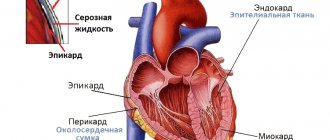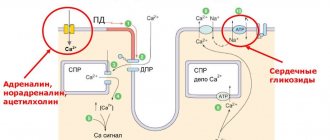Very often, cardiologists are faced with patient complaints of irregular heart rhythms or periodic manifestations of ischemia. The bulk of such symptoms are established during the simplest and most common diagnostic method - an electrocardiogram. In more complex cases, to make an accurate diagnosis, a Holter diagnosis may be prescribed, which is carried out throughout the day. In the absence of an accurate understanding of the degree of pathology, increased physical activity using a bicycle or treadmill may be added to general studies. But, unfortunately, there are situations when all these studies do not give an accurate result, and the patient complains of problems with heart rhythm. It is in such cases that cardiologists prescribe diagnostics using the EPI technique.
What is EFI?
Many heart diseases accompanied by rhythm disturbances are quite difficult to identify. It is rarely possible to detect such deviations using a conventional electrocardiograph, so the prescribed treatment may not always be adequate.
Electrophysiological research methods began to be introduced into medicine gradually. When performing a standard cardiogram and even when monitoring throughout the day, isolated heart rhythm disturbances cannot always be detected. Therefore, patients should know about cardiac EPI: what is it, how and why is it performed?
Electrophysiological stimulation of the heart helps provoke an arrhythmia so that it can be recorded on an ECG. This is achieved through impulse action, causing a physiological increase in heart rate, which in most cases becomes the cause of disruptions in cardiac activity.
EPI can be either invasive or non-invasive. The latter involves influencing the heart through the esophageal tube using special equipment. Invasive techniques are used for abdominal surgery or when an electrode is inserted into the heart chambers through a vein in the thigh.
Historical reference
Despite the fact that the EPI procedure on the heart began to be used relatively recently, experiments on electrophysiological techniques themselves began to be used at the end of the 18th century by the famous physician Luigi Galvani. He did not achieve much results, but over the following years his experiments continued to be developed by his students and followers.
A new revolution began in the 1970s, when a group of scientists rediscovered interest in this diagnostic method. Nowadays, an increasing number of doctors use the cardiac EPI method in their work.
Kinds
Transesophageal electrophysiological examination of the heart (TEC) is performed much more often, since with such interventions the likelihood of unpleasant consequences is much lower. However, the diagnostic value of invasive studies is much higher, since with the help of TEE it is possible to stimulate only the atrium on the left side, but when placing the electrode directly into the cardiac chambers, it is also possible to detect ventricular arrhythmias.
Carrying out PPEFI
There are two different types of invasive techniques: endocardial, epicardial. In the first case, EPI uses a thin electrode, which is subsequently inserted through the femoral artery into the ventricle or atrium. Epicardial pacing is done during open heart surgery.
Side effects
During the operation, although not dangerous, unpleasant side effects often occur. These include:
- Cardiac arrhythmia, which often leads to severe dizziness and even fainting. This is considered a completely normal situation, so the doctor does not interrupt the EPI of the heart, but simply sends a small electrical shock to subsequently restore the heart rhythm.
- Blood clots at the end of the inserted catheter. At times they can break off and therefore block other blood vessels. To avoid such situations, heparin-based blood thinners are administered during EPI.
- The areas where the catheter is directly inserted may begin to bruise or bleed. There is also the possibility of contracting an infection, so you should carefully listen to the advice of doctors.
Indications for electrophysiological examination
The choice of research method remains with the doctor. EPI of the heart is done strictly according to indications, among which are:
- Rhythm disturbances. Disturbances that are paroxysmal in nature. Typically, such states do not last long; they cannot be recorded by other methods.
- Chest pain. Acute pain is often accompanied by shortness of breath, wheezing and can occur even at rest. The skin turns pale, cyanosis is noted around the lips and nose, and pressure readings deviate.
- Presyncope. Sometimes, passing into fainting, for no apparent reason and in the absence of diseases of the nervous system.
- To determine the cause of cardiac arrest.
Transesophageal electrophysiological study is prescribed for the following pathologies and diseases:
- bradyarrhythmia that developed against the background of abnormalities in the sinus node,
- supraventricular tachyarrhythmias of various etiologies,
- tachycardic and bradycardic syndromes resulting from weakness of the sinus node,
- checking the effectiveness of an antiarrhythmic drug course,
- diagnosis of pathologies requiring the installation of a pacemaker,
- identification of arrhythmias provoked by medications.
Invasive EPS is required in situations where the patient is diagnosed with severe pathologies in cardiac activity, which are accompanied by severe clinical symptoms and can lead to death:
- decreased heart rate accompanied by loss of consciousness,
- supraventricular tachycardias: atrial fibrillation, SVC syndrome (Wolff-Parkinson-White),
- paroxysmal tachycardia, provoking ventricular fibrillation,
- bundle branch blocks, atrioventricular blocks of varying degrees of severity,
- to identify indications for the installation of a cardiac implant, radiofrequency ablation, and the use of a cardioverter.
Contraindications
Invasive electrophysiological examination of the cardiac muscle is not prescribed if the patient is diagnosed with the following diseases and conditions:
- myocardial infarction (acute phase),
- coronary syndrome,
- angina pectoris (newly detected or progressive),
- chronic heart failure,
- heart defects,
- hemorrhagic or ischemic stroke,
- cardiomyopathies accompanied by circulatory problems,
- thromboembolism and other vascular disorders,
- aneurysms,
- fever.
Conducting transesophageal EPI, in addition to the listed pathologies, is impossible for various diseases of the esophagus. Neoplasms, narrowings, adhesions, and diverticula are considered direct contraindications to manipulation. Also, TEE is not performed for acute inflammatory pathologies that have developed in the walls of the esophageal tube.
How to prepare for TEE, nuances of the procedure and diagnosis
When heart problems develop, they require immediate, close medical supervision. When a person consults a cardiologist, he does not always immediately receive complete information about his disease; first, an electrocardiogram is performed. In some cases, additional research may be required. When is TPEFI prescribed? What is the essence of this survey? How reliable is it? Understanding the procedure helps a person remain calm and have confidence in the healthcare provider.
Preliminary procedures
The need to use EPI in the diagnosis of various cardiac disorders depends not only on their type, but also on the possible consequences. For many arrhythmias, an urgent visit to a cardiac surgery hospital is necessary, since conservative treatment in these cases is ineffective and even dangerous.
Before invasive diagnostic examination techniques, various non-invasive tests are required to obtain a more or less accurate picture. EPI is possible only after completing the following diagnostic plan:
| Diagnostic procedure | Purpose of the study |
| History, physical examination | Detection of cardiac pathology and its differentiation from neurological abnormalities. Determination of factors contributing to the occurrence of arrhythmias |
| Nervous system research | |
| EEG | Exclusion of abnormal phenomena in the central nervous system |
| CT/MRI | Detection of neoplasms and other abnormalities in the structure |
| ECG 12 leads | Determination of scar formations in the myocardium, conduction disorders inside the ventricles, hyperexcitation syndromes |
| Carotid Dopplerography | Detection of cerebrovascular insufficiency |
| Orthostatic test | Diagnosis of fainting conditions |
| Daily monitoring (Holter) | Determination of abnormalities that cannot be detected using a standard electrocardiographic study |
| Stress test | Detection of ischemia |
| EchoCG | Detection of intracardiac pathologies, organ size and contractility |
Decoding the results
The normal result of invasive and non-invasive studies is the absence of rhythm disturbances when pulses are given through the electrode. Sometimes, if the result of TEE is negative, it is necessary to repeat it after 1-2 weeks, or the patient is prepared for insertion of an electrode into the heart through the vascular system.
If rhythm disturbances are identified, then its properties are determined:
- variety of ari src=”https://osostavekrovi.com/wp-content/uploads/2019/02d/elektrofiziologicheskoe-issledovanie-efi-9.jpg” class=”aligncenter” width=”580″ height=”330″[/ img]
- duration of the attack,
- appearance time,
- characteristics of electrical signals.
Based on the data obtained, patient management tactics are determined and further treatment is prescribed.
Doctor's orders
Due to the modern rhythm of life, more and more people are turning to doctors with the problem of arrhythmia, that is, a violation of the heart rhythm. Typically, in a healthy person, electrical signals pass through the heart uniformly and very clearly. But at the same time, high blood pressure, aging, heart attacks and many other reasons can lead to the fact that the heart gradually begins to become covered with scars or calcium deposits. All this greatly interferes with impulses. What leads to heart rhythm disturbances is whether it is regularity or consistency of the pulse. EPI of the heart can reveal such disorders.
Complications
Usually cardiac EPI is not accompanied by serious complications. However, sometimes negative consequences can develop, which are expressed by acute problems with cardiac activity. Most often, deviations occur against the background of artificially induced tachycardia. Meet:
- myocardial infarction,
- thromboembolism (when an undetected blood clot breaks off),
- acute paroxysmal angina.
Complications can occur if the probe is inserted too quickly. In addition, when performing TEE, it is possible that the electrode may be mistakenly lowered into the trachea instead of the esophagus. But the cause of such phenomena is most often an inexperienced specialist.
With invasive EPI, the possibility of complications also exists. Too long pacing of one zone can provoke perforation of the myocardium or endocardium. Depending on the number of punctures performed and catheters installed, the risk of bleeding increases.
Radiofrequency ablation
To solve problems with tachycardia, which manifests itself in an accelerated heartbeat, EFI RFA of the heart is used. Most often this is called cauterization, since in this case a small area of the heart is completely destroyed, in which the pathology of frequency excitation is formed. Those who are interested in how EFI RFA of the heart is done should be aware of the effect on tissue of radiofrequency signals, which have a damaging effect. This prevents the emergence of other pulse paths. But it does not harm the normal heartbeat, so the heart continues to function in its natural state.











